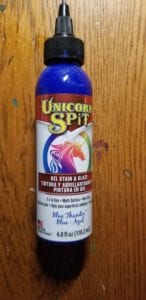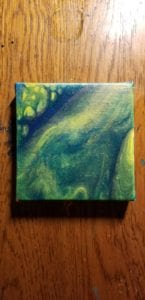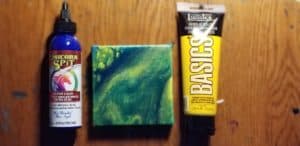Once you have some basics of acrylic pouring down, you’ll probably start wondering, What else can I use? Like the rest of us, you’ll see every object as an opportunity to pour, and you’ll search for new and better paints and additives to pour with.
A product of much discussion lately has been the magical, jasmine scented Unicorn SPiT. While technically a gel stain, this highly pigmented product has become a favorite for pourers. I had a chance to experiment with it recently, and I hope my experience will help you decide whether Unicorn Spit is right for you!

Things to Know About Unicorn SPiT
-
- It’s not like acrylic paint. First things first: If you’re expecting something that looks and acts like acrylic paint, you will be somewhat disappointed. Unicorn SPiT is a “gel stain and glaze” (according to the website), and can be used to color wood, metal, and more.It has a much different texture than acrylic paint, and it’s also highly pigmented. It is meant to be diluted, although you can use it without diluting.
- A little goes a long way. Although you can use this straight out of the bottle, that is not completely practical with a product that costs, on average, about $10 for four ounces.But don’t worry: You can dilute Unicorn SPiT in water. In fact, the official website states that it can be diluted up to 70 percent with water! I have tried with a dilution of about 20 percent, and found that the color is still vibrant and strong.
- When used with other paints, it can take over. The first time I used Unicorn SPiT, I went for it without dilution with Liquitex Basics acrylic paint in a pour. I used blue Unicorn SPiT and yellow Liquitex Basics acrylic, and the result was interesting!
 When I first poured, the blue and yellow were vibrant and separate. However, the next day the painting was mostly green (see above), because the Unicorn SPiT took over. Because of this, I would definitely recommend diluting your Unicorn SPiT at least a little bit if you decide to use it with acrylic paints. Or you could use only Unicorn SPiT.
When I first poured, the blue and yellow were vibrant and separate. However, the next day the painting was mostly green (see above), because the Unicorn SPiT took over. Because of this, I would definitely recommend diluting your Unicorn SPiT at least a little bit if you decide to use it with acrylic paints. Or you could use only Unicorn SPiT. - Sealing can be tricky. On the official Unicorn SPiT website, it states that you should use an oil-based sealant such as Polyurethane. This can be in conflict with traditional acrylic paintings, which should be finished with a water-based sealant like Polycrylic.Out of curiosity, I sealed a small Unicorn SPiT and acrylic painting with Polycrylic; it’s been about a month, and I haven’t seen any adverse effects…yet. It stands to reason that the manufacturer probably has a reason for recommending oil-based over water-based finishes, so if you intend on selling a painting that uses Unicorn SPiT, please make sure it is sealed properly.Otherwise, your painting may not age well and your piece will not hold up to the test of time, which could be a couple of years or a few months, depending on the amount of Unicorn SPiT you use.
Color theory is important. Because Unicorn SPiT only comes in 14 different colors, you’ll need to be creative with your color choices to achieve diverse rainbow tones. These colors are mostly basic colors, with just a few exciting colors available. Make sure you understand which colors complement ether and which combinations could turn into fabulous, expensive, jasmine-scented mud!

So, Is It Worth It?
While it’s fun to tell people that I recently made a piece using Unicorn SPiT, I’m not convinced that this product is economical for pour-style painting. I’ve seen some truly brilliant repurposed wood cabinets using Unicorn SPiT, and that is definitely a future project for me. But I couldn’t find enough benefits to justify continuing to use it in poured paintings.
What is your opinion about Unicorn SPiT? Have you found a way to incorporate it into your pours? We want to see! Show us your creations so we can see Unicorn SPiT at work.
Read Next:
Golden Fluid Acrylic Review and Test

Sara Wagner is an author and artist from Upstate New York. She is the owner of Studio Blackwater and can typically be found covered in paint, cats, or her two young daughters. You can find her on Facebook and Instagram as @studioblackwater.

I have used Unicorn Spit in pours. I found that when using a combination of Unicorn Spit and acrylics I need to make sure I adjust my flotrol/water/paint to be sure I have the same consistency because the Unicorn Spit isn’t as thick and more pigmented. I am a fan of Unicorn Spit and have used it on various projects but would not purchase it with the intent of only using it for pours only due to the cost.
I agree with the need to adjust the recipe for better consistency when using Unicorn Spit, Jill. It’s a bit pricey but it’s fun to use on a variety of projects.
The reason you are to use an oil based product to seal your Unicorn Spit project is because once dry the Unicorn Spit will dry to a chalky dull finish. If your sealant is a water based sealant it will “reactivate” your Unicorn Spit and your design wl be lost.
Thank you so much for your insight, Tisha! I’m sure other pourers will find your comment helpful.
Can you avoid the sealing issue when using both acrylic (water based) and Unicorn Spit (Oil) by sealing the finished, cured piece with a resin? Thank you!
Yes! I find that using resin works perfectly to seal.
I love the unicorn spit. The colors are bright and I made some beautiful Christmas gifts using it. I did seal the with several coats of polyurethane. It us expensive and wouldn’t use it for large pours though
I’ve been experimenting with the Metallics a lot-I can’t get over how vibrant they are!
I’ve been making coasters with SPiT lately and loving the result. Thanks for sharing!
I did a pour with Unicorn Spit and I was so glad I did because it turned out wrong (it was my first real pour and I was going for something specific), and so I was able to wipe it all off and do it again.
I react to scented products… just how scented is Unicorn spit??